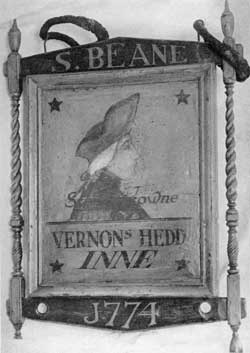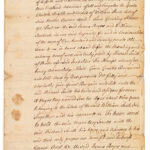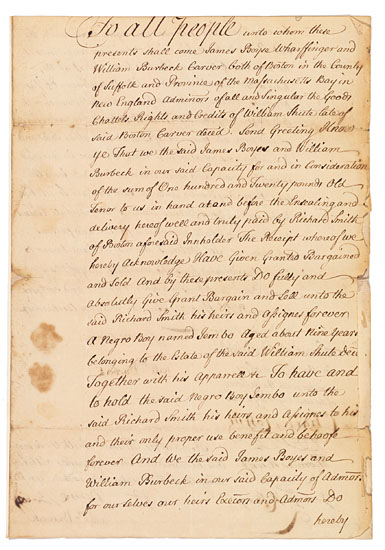If you have a romanticized idea about colonial taverns, leave those thoughts at the old inn’s front doorstep. You will soon meet your guide, Jembo, a young Black person living in Boston. He is standing near you under the Vernon’s Head tavern sign, right at the northeast corner of the State Street and Merchant’s Row intersection. Welcome to 18th century Boston, a busy place.
Although the known details of Jembo’s life can be counted on fewer than five fingers, we know that he was enslaved.
We know this because of the surviving bill of sale that came up for auction in the recent past (Swann), an excerpt of which is below. Although not privy to the complete document, the page we do have a copy of [displayed on this page] is where we first learn of Jembo. The ship carver, William Shute, had died without a will, and some if not all of his property was sold off, and that included Jembo.
“To all people unto whom these presents shall come James Boyes Wharffinger* and William Burbeck Carver both of Boston . . . [administrators] of [the estate of] William Shute late of said Boston Carver. . . for and in Consideration of the sum of One hundred and Twenty pounds Old Tenor . . . paid by Richard Smith of Boston aforesaid Innholder . . Do . . . Sell unto the said Richard Smith . . . a Negro Boy named Jembo unto the said Richard Smith” (Swann).
Before the sale his life may have revolved around the world of ship carpentry shops near Boston Harbor. Although a youngster at the time, Jembo may have been learning, if only through observation, the art of wood carving in Shute’s shop. By 1730, the Shutes and one other extended family were the preeminent shipcarvers in Boston (Lahvis).
Perhaps Jembo was enlisted to sharpen tools. Among the many implements were carving tools, a grindstone with its frame and trough, a cross cutsaw, gimblet tap borers(Merriam- Webster), holdfasts for clamping down boards (Sloane), and augers, as noted in Shute’s probated inventory.
“20 Carving Tools at 2/6 & 73 at ⅓ 7-1-3
One Grindstone frame & trough 2-10-0
One Cross Cuttsaw 70/four Benches 80/ 7-10-0
Gimbletts Tap borers & Sundries 0-8-0
Three trays 5/ four holdfasts 32/ 1-17-0
Two Augers & one pair of Hinges 0-10-0
One Spade 16/ two table Blocks 16/ 1-12-0” (Shute)
Also appraised for monetary value are two people, at “One Negro Boy” for one hundred pounds and “One Negro Woman” for twenty. It is not unlikely the young person was Jembo.
Learning ship carpentry would have positioned him to earn his own money in the future, depending on whether or not given permission by his enslaver. Artisanal work was one of the four main types of work for the enslaved, the others being domestic servitude, unskilled labor, and work on a ship (Hardesty).
Also appraised for monetary value are two people, at “One Negro Boy” for one hundred pounds and “One Negro Woman” for twenty. It is no unlikely the young person was Jembo.
Learning ship carpentry would have positioned him to earn his own money in the future, depending on whether or not given permission by his enslaver. Artisanal work was just one of the four main types of work for the enslaved, the others being domestic servitude, unskilled labor, and work on a ship (Hardesty).
He would have joined the ranks of many enslaved people in Massachusetts who became artisans. Here are some of the occupations culled from runaway advertisements in Massachusetts.
Barber – Blacksmith – Butcher – Carpenter – Caulker – Chimney – Sweep – Chocolate-maker – Cooper – Currier – Doctor – Hous-joiner – Husbandry – Leather dresser – Mariner – Painter – Ship carpenter – Shoe maker – Sugar-baker – Tailor – Wagon-maker – Wheelwright (Bly)
We do not know the conditions under which Jembo lived while attached to either the ship carver, or subsequently the innkeeper. Was he treated humanely? What was the attitude of his enslavers towards him? Was he overworked? Appreciated?
However, we do have a small clue. On at least two different occasions, people the innkeeper enslaved sought their freedom by foot. To try and get them back, Smith paid for advertisements in the Boston Gazette newspaper, promising a reward to anyone who captured and returned either Cato or Diana.
Cato, an African American man about 23 years old, escaped in 1746 from the innkeeper. He spoke English fairly well, and was well versed in the shoemaking trade. When he escaped, he had on a light colored cloth coat with mohair buttons, a pair of homespun breeches, two homespun jackets, yarn stockings, and round toed shoes. Perhaps he succeeded in finding work on one of the many ships nearby that did business in Boston. There was good reason most runaway ads ended with the following words, including the one seeking Cato’s return:
“All Masters of Vessels and others, are hereby caution’d against concealing or carrying off said Servant, on Penalty of the Law” (Cato).
Diana, a Black woman in her mid twenties, also escaped from Richard Smith, the innkeeper. She left on a cold February Sunday three years after Cato. Perhaps she was able to take advantage of the Smith family’s removal to Puritan services and the preachings of their minister on that Sabbath day. Even though it was winter, she was known only to have on a single patched homespun gown when she took flight (Diana).
We do not know if Cato or Diana succeeded.
Based on the information gleaned from the ads, the innkeeper might have been a harsh taskmaster. Both Cato and Diana ran off during the coldest time of year in New England, but we can only speculate as to their reasoning and only guess as to Jembo’s treatment.
Another clue can be pulled from Jembo’s name. What was its origin? There is a port in Saudi Arabia across the Red Sea from Egypt with the same name. Was he trafficked through that harbor, thus the name? Most kidnapped Africans were sold from west Africa, and not near the Arabian peninsula. So it is unlikely.
Many in his circumstances were named by their enslavers after towns, cities and other places, including Boston, London, Newport, Paris, and Portsmouth, but in many or most with no direct connection to the enslaved person.
Another possibility is that his name was African, but Jembo (and Yembo) is not found in my reference, Julia Stewart’s 1,001 African Names.
In late spring of 1749 a Richard Smith placed the following advertisement:
“A Fine Parcel of very likely Negro Boys to be sold by Richard Smith, very reasonably, and to be seen at his House near the old North Meeting House” (Likely).
If the advertisement referred to the same Richard Smith, it may be the case that Jembo was being put up for sale with others.
There may be more to discover about Jembo and it is not unlikely that any one of us is living near a descendant, direct or otherwise, and are possibly one ourselves.
Thanks go to all the unsung enslaved persons who played a role in the growth of this country.
Susan Elliott
Independent Researcher
—–
WORKS CITED
“Advertisement.” Boston Evening-Post (Boston, Massachusetts),
no. 721, June 5, 1749: [2]. Readex: America’s Historical Newspapers. https://infoweb-newsbank-com.nehgs.idm.oclc.org/apps/readex/doc?p=EANX&docref=image/v2%3A1089C792E64CF650%40EANX-108EC23C4F40C130%402360025-108EC23C8DFA0C78%401-108EC23D4C72E3C0%40Advertisement.
Bly, Antonio T. Escaping Bondage. Lexington Books, 2012,
Plymouth, United Kingdom. NOTE: I culled the list of occupations from the index of advertisements at the back of the book.
Cato – “Advertisement.” Boston Gazette (Boston,
Massachusetts), no. 1251, March 4, 1746: [3]. Readex: America’s Historical Newspapers. https://infoweb-newsbank-com.nehgs.idm.oclc.org/apps/readex/doc?p=EANX&docref=image/v2%3A1036CD2E61FB47A0%40EANX-1046E1BC07374722%402358836-1046E1BC37FCC701%402-1046E1BCB7C9796C%40Advertisement.
Diana – “Advertisement.” Boston Gazette (Boston,
Massachusetts), no. 1512, March 7, 1749: [2]. Readex: America’s Historical Newspapers. https://infoweb-newsbank-com.nehgs.idm.oclc.org/apps/readex/doc?p=EANX&docref=image/v2%3A1036CD2E61FB47A0%40EANX-10444EC71BEEB26E%402359935-10444EC735DB4342%401-10444EC7920B9523%40Advertisement.
“Gimblet.” Merriam-Webster Dictionary.
Hardesty, Jared. Black Lives, Native Lands, White Worlds: A History of Slavery in New England. University of Massachusetts Press, 2019.
Lahvis, Sylvia Leistyna. “Icons of American Trade: The Skillin Workshop and the Language of Spectacle.” Winterthur Portfolio
27, no. 4 (1992): 213-33. Accessed March 6, 2021. http://www.jstor.org/stable/1181434.
“ A likely parcel of negro boys” – “Advertisement.” Boston
Evening-Post (Boston, Massachusetts), no. 721, June 5, 1749: [2]. Readex: America’s Historical Newspapers. https://infoweb-newsbank-com.nehgs.idm.oclc.org/apps/readex/doc?p=EANX&docref=image/v2%3A1089C792E64CF650%40EANX-108EC23C4F40C130%402360025-108EC23C8DFA0C78%401-108EC23D4C72E3C0%40Advertisement.
Sloan, Eric. https://ar.pinterest.com/pin/186969822014347169/
Shute, William. Inventory. Suffolk County (Massachusetts)
probate records, 1636-1899, Probate records v. 38-40 1745-1747, 8501, Book 39, pages 38-40.
Stewart, Julia. 1,001 African Names. Citadel Press, 1996, New York, N.Y.
Swann Galleries. Sale 2204 – Lot 2. Swann Galleries. Deed of sale
for “A Negro boy named Jembo.” https://catalogue.swanngalleries.com/Lots/auction-lot/(SLAVERY-AND-ABOLITION)-Deed-of-sale-for-A-Negro-boy-named-J?saleno=2204&lotNo=2&refNo=617338

“A Pre-Revolutionary Boston Tavern Sign: The Vernon’s Head was at the corner of State Street and Merchant’s Row. It was named for the English Admiral, Edward Vernon, whose capture of Porto Bello in the West Indies was an outstanding naval feat. Mount Vernon, the Washington estate, was also named for him.”
Harris, Charles E. “Flashback: Signs for Mariners.” Collectors Weekly. 23 March 2009. https://www.collectorsweekly.com/articles/signs-for-mariners/
WILLIAM SHUTE’S PROPATED INVENTORY/TRANSCRIPTION


“
“Shute’s Inventory 8501
An Inventory of the Estate of William Shute [deceased] as [appraised] by Mr Samuel Hunt Nathanael Greenwood and Mr James Hughes – ~
One Black Walnutt oval Table ₤ 5-0-0 £
One Small Maple Table 35/ One Desk ₤5 6-15-0
Eleven Leather Chairs ₤6–/one pair of brass andirons 5/ 8-10-0
Half a dozen of Saucers 0-12-0
Half a [dozen] of Cups & Saucers 1-5-0
Four Bowls and a Canoe 1-6-0
[Subtotal] 23-28-0
Thirteen Saucers & Two Cups 1-10-0
One Dozen of Earthen plates 1-4-0
One Teapott & 2 Crackt China Bowls 0-10-0
Thirteen Glass Beakers and Cruits 1-16-0
[Subtotal] 5
One Silver Porringer two large Silver Spoons three small ditto
One Small Cup 14.2 oz. (?) at 40/(P?) oz 28-4-0
One Oak Square Table 10/ one Small Round Table 12/ 1-2-0
One warming pan 12/ one Lanthorn 5/ 0-17-0
Three Black Chairs 12/Six Kitchen Chairs 18/ 1-10-0
One pair of Brass Candlesticks 12/ 3 ditto 8/ 1-0-0
Two Iron ditto 1/ one Box Iron & two heaters 12/ 0-13-0
One Copper Skillet 20/ two Bellmettle 60/ 4-0-0
[Subtotal] 9-2-0
One Small Dish Kittle 12/ one Iron Back 20/ 1-12-0
Two Iron andirons 30/ three small potts 25/ 2-15-0
Two Trammells 30/ one Lamp Trammell half [dozen](Squres?) 10/ 2-0-0
One pair of Chamber Andirons 12-0-0
Fifteen pound of old pewter at 5/(?) 3-15-0
Fifteen pound and half of pewter at 7/6 (?) 5-16-3
Sundry tin ware one Brass pott 0-17-0
One Stone Jar 10/ two Wooden Ladle one Rolinpin one pail 0-16-0
One Spit one Fender two frying pans one Gridiron 0-13-0
[Subtotal] 18-16-3
One Hardmettle Teapott & two Canisters 0-5-0
One Brass Kittle 70/ one Small ditto 6/ 3-16-0
Three Knives & three forks 0-6-0
One
—————————————————————————————–
One Looking Glass ₤14. Two Butter Tubs ₤14-6-0
One Small oval Table Walnutt 0-2-0
One Old Fashion Case of Draws 2-0-0
2 Basketts & one Box 10/ 2 large ^Gilt^ pictures 40/ 2-10-0
Seven Small Guilt pictures 14/ light plain ditto 8/ 1-2-0
[Subtotal] 26-5-0
Six four back Chairs 30/ 1-10-0
One Callico quilt 80/ one pair Blanketts 70/ 7-10-0
One Feather Bed Bolster & pillow 61 (?) at 3/3/ (?) 10-11-3
Two pair of Sheets 30/ one (Sack?) in Bottom Bedstead 40/ 3-10-0
One (Suit?) of Curtains & window Curtains 10-0-0
[Subtotal] 33-1-3
One Quarto Bible 40/ to Sundry Books 30/ 3-10-0
One Great Coat ₤9 – a Suit of Broad Cloth ₤10-10 19-10-0
One old Suit of Broad Cloth 90/ one great Coat 20/ 5-10-0
One old Druggett Coat & Breeches 0-10-0
One Dark pair of Silk hose 20/thre pair of [ditto] 15 1-15-0
One pair of worsted hose 10/ two hatts & Case 60/ 3-10-0
One Black Coat and Jackett 5-0-0
Six Shirts ₤5-15/ One Napkin two pillowbiers [pillowcases] 15/ 6-10-0
[Subtotal 45-5-0]
One (P?)ine Table one Joint Stool 1-0-0
One Case of Draws ₤6 – One Small bed & Beding 60/ 9-0-0
Two Bags 5/ one Baskett 8/ 0-13-0
One old Bed & Blankett 2-0-0
Two Small Feather Beds one Bolster 70 (?). At 7 (?) 24-10-0
[Subtotal] 37-10-0
One Small Arm ₤6
One Cutlass & one Cartouch Box 1-0-0
One Small Looking Glass 15/ one Crib 5/ 1-0-0
One Sword & two Cartouch Boxes 1-0-0
Three under Waistcoats 3-0-0
One Tea Kittle 20/One Coffee pott 10/ 1-10-0
One pair of tongs and shovell fire one Trammell 1-2-0
One pair of shoes 0-10-0
[Subtotal] 15-2-0
20 Carving Tools at 2/6 & 73 at ⅓
One Grindstone frame & trough 2-10-0
One Cross Cuttsaw 70/four Benches 80/ 7-10-0
Gimbletts Tap borers & Sundries 0-8-0
Three trays 5/ four holdfasts 32/ 1-17-0
Two Augers & one pair of Hinges 0-10-0
One Spade 16/ two table Blocks 16/ 1-12-0
One Cloaths line 0-10-0
[Subtotal] 21-18-3
Boats Masts Oars & paddles 0-1-0
Three
—————————————————————————————–
Three set work tubs one Small ditto 1-5-0
One hoe 2/ 50 (?) of old Iron at 12 (?) (?) 2-12-0
One pair of Bed screws 25/ One Close Stool pan 12/ 1-17-0
One Tray one Wooden Candlestick one knife Cleaner 0-4-0
One Bear Barrell one Rake 0-10-0
16 Glass Bottles one Jarr 1-0-0
One Negro Woman 20-0-0
[Subtotal] 28-8-0
One Negro Boy 100-0-0
[Subtotal] ₤392-2-9
House & Lands 1100-0-0
Old Tenor ₤1492 -2-9
Saml Hunt
Nathl Greenwood
James Hughs
Suffolk ss
By the Honble Edward Hutchinson Esqr Judge of Probate & James Boyce and William Burbeck Admin:rs presented the within written and made Oath that it Contains a true and perfect Inventory of the Estate of William Shute deced so far as hath come to their knowledge and that if more hereafter appear they will Cause the same to be added The Subscribing Appraizers were also sworn at the same time as the Law directs – — Edwd Hutchinson
Boston May 27:1746
I Allow the widow of the Deced the sum of Sixty five pounds old Tenor to be taken out of such part of the moveables as she shall Choose at the Appraized Value. — Edwd Hutchinson”
Examd (?) Abelcher Regr (Suffolk)”
Shute, William. Inventory. Suffolk County (Massachusetts) probate records, 1636-1899, Probate records v. 38-40 1745-1747, 8501, Book 39, pages 38-40. Transcribed by Susan G. Elliott, 21 March 2021
—–

